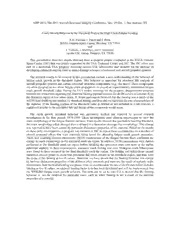
NASA Technical Reports Server (NTRS) 20110012682: Crack Growth Behavior in the Threshold Region for High Cycle Fatigue Loading PDF
Preview NASA Technical Reports Server (NTRS) 20110012682: Crack Growth Behavior in the Threshold Region for High Cycle Fatigue Loading
ASIP 2011, The 2011 Aircraft Structural Integrity Conference, Nov. 29-Dec. 1, San Antonio, TX Crack Growth Behavior in the Threshold Region for High Cycle Fatigue Loading R.G. Forman, J. Figert and J. Beek NASA Johnson Space Center, Houston, TX 77058 and J. Ventura, J. Martinez, and F. Samonski Jacobs ESC Group, Houston, TX 77058 This presentation describes results obtained from a research project conducted at the NASA Johnson Space Center (JSC) that was jointly supported by the FAA Technical Center and JSC. The JSC effort was part of a multi-task FAA program involving several U.S. laboratories and initiated for the purpose of developing enhanced analysis tools to assess damage tolerance of rotorcraft and aircraft propeller systems. The research results to be covered in this presentation include a new understanding of the behavior of fatigue crack growth in the threshold region. This behavior is important for structural life analysis of aircraft propeller systems and certain rotorcraft structural components (e.g., the mast). These components are often designed to not allow fatigue crack propagation to exceed an experimentally determined fatigue crack growth threshold value. During the FAA review meetings for the program, disagreements occurred between the researchers regarding the observed fanning (spread between the da/dN curves of constant R) in the threshold region at low stress ratios, R. Some participants believed that the fanning was a result of the ASTM load shedding test method for threshold testing, and thus did not represent the true characteristics of the material. If the fanning portion of the threshold value is deleted or not included in a life analysis, a significant penalty in the calculated life and design of the component would occur. The crack growth threshold behavior was previously studied and reported by several research investigators in the time period: 1970-1980. Those investigators used electron microscopes to view the crack morphology of the fatigue fracture surfaces. Their results showed that just before reaching threshold, the crack morphology often changed from a striated to a faceted or cleavage-like morphology. This change was reported to have been caused by particular dislocation properties of the material. Based on the results of these early investigations, a program was initiated at JSC to repeat these examinations on a number of aircraft structural alloys that were currently being tested for obtaining fatigue crack growth properties. These new scanning electron microscope (SEM) examinations of the fatigue fracture faces confirmed the change in crack morphology in the threshold crack tip region. In addition, SEM examinations were further performed in the threshold crack-tip region before breaking the specimens open (not done in the earlier published studies). In these examinations, extensive crack forking and even 90-degree crack bifurcations were found to have occurred in the final threshold crack-tip region. The forking and bifurcations caused numerous closure points to occur that prevented full crack closure in the threshold region, and thus were the cause of the fanning at low-R values. Therefore, we have shown that the fanning behavior was caused by intrinsic dislocation properties of the different alloy materials and were not the result of a plastic wake that remains from the load-shedding test phase. Also, to accommodate the use of da/dN data which includes fanning at low R-values, an updated fanning factor term has been developed and will be implemented into the NASGRO fatigue crack growth software. The term can be set to zero if it is desired that the fanning behavior is not be modeled for particular cases, such as when fanning is not a result of the intrinsic properties of a material.
